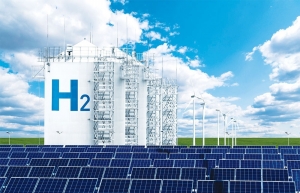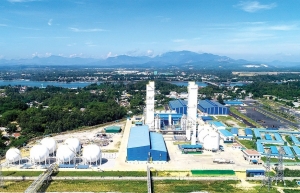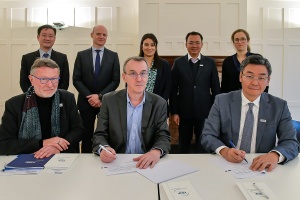Utilising the broad application of green hydrogen
Energy in Vietnam, mainly produced from coal, is estimated to represent about 70 per cent of Vietnam’s total emissions by 2030. Since 2019 it has been encouraging that the Vietnamese government has quadrupled its solar and wind capacity.
 |
| Patrick Haverman-Deputy resident representative United Nations Development Programme |
Vietnamese wants to achieve net-zero emissions by 2050, and an initial pledge of $15.5 billion will be mobilised under the Just Energy Transition Partnership. It aims to support Vietnam’s energy transition, which includes reducing its peak annual power sector emissions by up to 30 per cent, increasing the share of renewables in electricity generation to at least 47 per cent by 2030 from 36 per cent, revising the nation’s peak coal capacity, and reaching peak emissions in 2035.
The successful delivery of these targets will also entail a small, but meaningful role from green hydrogen, which will grow in the coming years. Globally, green hydrogen from water electrolysis plays a small role, having contributed only 0.03 per cent of hydrogen production in 2020.
However, improving electrolyser technologies and falling renewable energy costs are poised to make green hydrogen cost competitive by 2030. Crucially, countries with high renewable energy potential, preferential trade relationships, political stability, and proximity to major importers in the Asia-Pacific region, such as Vietnam, stand to benefit, particularly as carbon border pricing may play a growing role.
Green hydrogen has broad applications, which include but are not limited to shipping, transportation, steel, fertilisers, and chemicals, many of which are sectors that are difficult to decarbonise. Its production and use remain a novel field here, but the energy medium has garnered interest. Notably, Vietnamese company TGS Green Hydrogen is poised to build the country’s first electrolyser with $840 million investment, signalling efforts to build a cohesive national strategy must occur sooner than later.
A joint UN Development Programme and Institute of Energy study takes the preliminary steps to assess the potential role of green hydrogen production from water electrolysis, and the use of green hydrogen for reducing greenhouse gas emissions on a large scale, accelerating the clean energy transition in Vietnam.
Preliminary findings include economic and statistical analysis using the most up-to-date data on domestic electricity and renewable electricity projections, utilising assumptions from International Renewable Energy Agency, and the International Energy Agency, and the 2021 Vietnam Energy Outlook.
These projects provide estimates for Vietnam’s current and future green hydrogen and ammonia demand, a discussion on the national policy and legislative framework for development, and can compare against global developments both in use and policy. Our colleagues and expert team will shortly share a more detailed set of findings thus far, including key considerations for Vietnam.
To address the potential for hydrogen production from water electrolysis in Vietnam, there were three key elements from our findings.
Firstly, to provide a realistic estimate of green hydrogen, three different scenarios were developed based on a fully decentralised solar and wind generation, the provision of renewable electricity from a supply utility, and the mixed provision of grid electricity and some dedicated onshore wind and solar power. Our findings highlight that, if the electrolysers run at 90 per cent capacity throughout the year, at least 11.49 million tonnes of green hydrogen could have been produced in 2020 and as much as 18.78 million tonnes could be produced by 2050.
Secondly, the levelled cost of hydrogen is projected to decline markedly in each of the three scenarios. Also known as the average cost of hydrogen per kg over the lifecycle of the project, the costs are projected to decline from as high as $11.81 per kg at 65 per cent capacity to as low as $2.42 per kg at 90 per cent capacity by 2050. The reduction in costs can be attributed to the rapidly declining costs in key input technologies such as storage batteries.
Thirdly, it is important to highlight the role played by countries governments to set targets, develop strategies, regulation, and provide market-based incentives towards decarbonisation. As a major challenge, the global development of legislation, standards, and trade rules on hydrogen remains in the early stages.
Among the 40 or so governments that have developed national hydrogen strategies, key actions include the pursuit of MoUs to advance cooperation on research and development, working groups to address harmonisation of standards and regulations, engagement in public-private partnerships, and information sharing on the development of secure value chains and guarantees of origin, among other activities.
Industry investors must also be able to set technical targets for electrolyser production cost reductions based on capacity building, research and development, and appropriate sectoral applications.
The production of green hydrogen and energy carriers such as ammonia and renewable energy plants can partially meet Vietnam’s energy storage and consumption demand in transportation and other sectors. It can also help Vietnam achieve its commitments on net-zero emissions.
We will continue working with the Institute of Energy in green hydrogen production and use, and on accelerating the green energy transition in Vietnam.
 | Race for hydrogen energy heating up against backdrop of carbon-free future The emerging hydrogen market is set to be very complex, and for Vietnam to become a producer and exporter of green hydrogen over the next five years, there will be huge challenges, but the potential upsides are vast. |
 | Creating suitable models for exploitation of hydrogen Investors are ramping up the development of hydrogen to meet the rising energy demand in Vietnam. |
 | HDF Energy inks MoU with PTSC to build hydrogen power plants Hydrogène de France SA (HDF Energy) has signed an MoU with PetroVietnam Technical Services Corporation (PTSC) to jointly develop, finance, and build HDF's hydrogen power plants in Vietnam. |
What the stars mean:
★ Poor ★ ★ Promising ★★★ Good ★★★★ Very good ★★★★★ Exceptional
Related Contents
Latest News
More News
- CME Solar strengthens position in Vietnamese renewables (December 30, 2025 | 11:21)
- Self-care signals shift towards sustainable healthcare (December 30, 2025 | 10:12)
- GreenYellow marks five years of clean energy growth in Vietnam (December 26, 2025 | 15:51)
- TCP Group partner with VNUS to launch water conservation project (December 25, 2025 | 14:00)
- Heavy industries set for pilot greenhouse gas quotas (December 25, 2025 | 10:00)
- Swedfund invests in MSME growth and climate action in Vietnam (December 19, 2025 | 11:42)
- GreenYellow brings solar energy to light up remote schools in Tuyen Quang province (December 19, 2025 | 08:00)
- Charge+, Grab partner to develop EV charging network in Vietnam (December 18, 2025 | 17:11)
- Linking sci-tech and innovation to Vietnam’s net-zero future (December 18, 2025 | 14:31)
- Driving double-digit growth through green and circular transformation in Vietnam (December 17, 2025 | 09:00)

 Tag:
Tag:



















 Mobile Version
Mobile Version